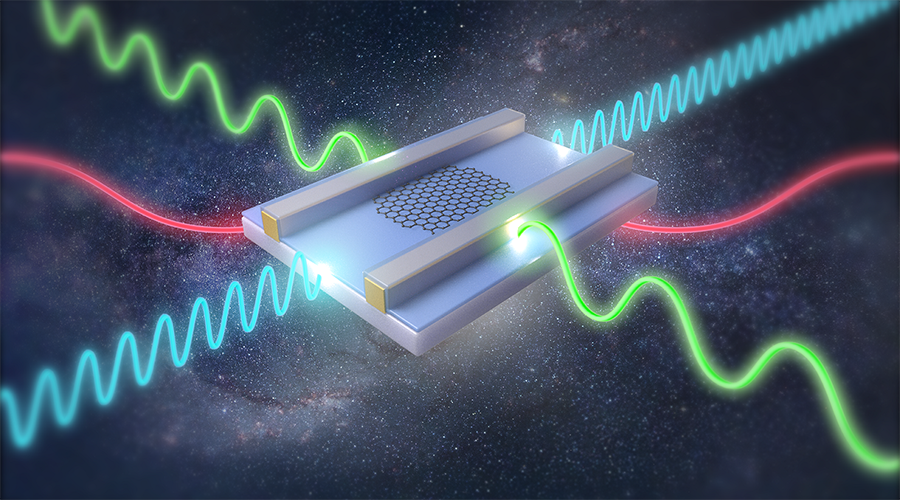A research group has framed a pathway for the mass manufacture of sensors, which has the potential to concurrently detect mercury, lead, and E. coli in flowing tap water.

An artist’s rendering of the water sensor. A graphene-based nanolayer and two electrodes are attached at the top. They can be tailored to detect heavy metals, bacteria, pharmaceuticals, pesticides, coronaviruses, and other common contaminants in water. Image Credit: Argonne National Lab.
This research was a joint effort by researchers from Argonne National Laboratory, the Pritzker School of Molecular Engineering at the University of Chicago, and the University of Wisconsin-Milwaukee.
The team’s innovation has the potential to help safeguard public health by providing early warning for contamination.
Traditionally, sensors designed to measure contaminants in water have suffered from reliability issues and the inability to detect faulty devices. Improved sensors could avert health crises.
Haihui Pu, Pritzker Molecular Engineering and Argonne Scientist, University of Chicago
At the center of such sensors lies a one-nm-thick layer of oxygen and carbon atoms, a form of graphene, which has been coated on a silicon substrate. This graphene material serves a similar purpose to the semiconductors found in computer chips.
Gold electrodes are then imprinted onto the graphene surface, followed by a nanometer-thick insulating layer of aluminum oxide. Each sensor has been designed to detect one of the three toxins: lead, mercury or E. coli.
One of the main challenges when it comes to the mass manufacture of these sensors has been assessing their quality.
Tiny areas of undesired porosity can form in the ultra-thin insulating layer. This porosity allows electrons from the bottom graphene layer to escape into the top insulating layer. This leakage can have a negative effect on its effectiveness as an insulator and can result in unreliable sensor responses.
The team's findings were recently published in the journal Nature Communications, where a screening technique was used to determine defective devices prior to mass production.
The method involved measuring the electrical response of the insulating layer while the sensor was submerged in water. The main goal was to ensure that the screening process did not damage the sensor. By employing this technique, the team was able to successfully identify structural defects in the insulating layers. They were then able to establish criteria to detect faulty devices.
To demonstrate the efficacy of their approach, the research group assessed a three-sensor array that had the ability to concurrently detect mercury, lead, and E. coli in flowing tap water. With the help of machine learning algorithms to examine the outcomes, they were able to measure toxin levels down to the parts per billion, even in interfering elements.
Any Form of Water
The beauty of the sensors is that you can apply them in any form of water, not just tap water. What’s more, you can combine three, thirty, or three hundred sensors, with each tailored to detect different constituents.
Junhong Chen, Lead Water Strategist and Crown Family Professor, Pritzker Molecular Engineering, University of Chicago
These not only include heavy metals and bacteria but pharmaceuticals, pesticides, coronaviruses, and a common contaminant in water, per- and poly-fluoroalkyl substances. They could also include critical resources, such as cobalt for batteries and nitrogen and phosphorus as nutrients for plants and animals.
Once problematic or valuable elements are identified and removed, the sensors can be used to assess the cleanliness of treated water. The results can guide the safe reuse of water, including potable use, agriculture and irrigation, groundwater replenishment, and industrial processes.
Global Health Problem
Chen also hopes to commercialize this technology through his own startup company.
But water contamination poses a global health problem demanding collective efforts.
Junhong Chen, Lead Water Strategist and Crown Family Professor, Pritzker Molecular Engineering, University of Chicago
The screening method provides a flexible tool for tracking water quality and improving its safe reuse. As scientists tackle this critical issue, their efforts serve as a beacon of hope for a healthier, more sustainable future.
Journal Reference:
Maity, A., et al. (2023) Scalable graphene sensor array for real-time toxins monitoring in flowing water. Nature Communications. doi.org/10.1038/s41467-023-39701-0.